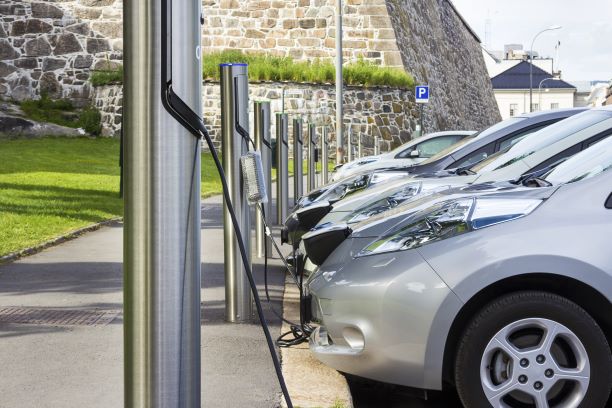Last month, I joined a group of experienced and highly motivated healthy climate advocates, the MCAT team (Mobilizing Climate Action Together), for a day of lobbying in Salem, Oregon. Our overall agenda included a variety of bills before the legislature, but my personal priority was convincing lawmakers to increase funding for electric vehicles. The money would appear as a $750 – $2500 cash bonus for residents buying EVs, under the Oregon Clean Vehicle Rebate Program administered by the state’s Department of Environmental Quality. Although the program also includes rebates for plug-in hybrids and cars powered by hydrogen fuel cells, the majority of the funds enable purchases of battery electric vehicles (BEVs), which use no gasoline or diesel fuel. Oregon is not alone in this, as many states offer their citizens some form of public subsidy to buy EVs. These rebates or state tax credits augment the federal tax credit of up to $7500, though the amounts vary widely and are significant for only a small number of states (led by California).
Since 2018, OCVRP has provided nearly 30,000 rebates to Oregonians, in increasing number over the years. The recent explosion of EV models offered by all the large automakers has made the program wildly popular, so much so that the funds allocated in 2023 ran out almost entirely within just a few months. The 2022 funding was enough for DEQ to give rebates all year long, but in 2023 the money was exhausted by June. Oregonians who applied too late were placed on a waitlist, with the expectation that the legislature would renew funding for the program in 2024. Most EVs in Oregon (and nationwide) have been purchased by higher income families, so part of our agenda in Salem was to convince Senators and Representatives to increase the fraction of new funds dedicated to the “Charge Ahead” program for those with low or moderate incomes.
The Oregon legislature was in session for just 35 days this year, and many of our requests for climate and renewable energy funding were met with the usual refrain about budget limitations. Nonetheless, some parts of the climate advocacy agenda, especially the Healthy Homes program to offer assistance for weatherizing, were well-received and robustly funded, even receiving Republican support. But monies for the EV program were not increased, and the DEQ’s new program announcement indicates that rebates will only be available for applicants in a two-month window beginning April 3. Last month, Oregon Public Broadcasting reported that program coordinator Erica Timm expects only $12.6 million in new allocations, far short of the $48 million that OCVRP estimates is needed to avoid another suspension. The money will first go to the over 500 applicants remaining on the waitlist from last year, and, in accordance with the authorizing law, 20% will go to lower income citizens under the Charge Ahead program.
I was disappointed by this outcome, of course, but would not have found it particularly noteworthy except for what arose during a meeting of our lobby group with a Democratic lawmaker who has long been a champion of healthy climate legislation. It appears that a particular conversation about EVs is starting to take hold in the legislature, which may not bode well for their future in the state, and (I speculate) may have contributed to the unwillingness to increase funding. We have gotten used to the usual complaints about EVs, having to do with higher cost, low mileage range, and inadequate or poorly maintained charging infrastructure. But here is an issue that is more difficult to handle: growth in EVs should be limited because they are overburdening the electricity grid, threatening blackouts that could injure Oregonians throughout the state. At least at first blush, the argument can seem quite compelling, even to Democrats who are favorably disposed to using the power of government to address the climate crisis.
The seriousness of this discussion came home to me last week, when the New York Times reported that utility companies across the country are projecting that electric power demand in 2028 will be twice what they forecast just a few years ago. The article attributes the sharp increase to the proliferation of data centers (including for cryptocurrency), the resurgence in manufacturing driven by the Bipartisan Infrastructure Law and Inflation Reduction Act, and, yes, the explosive growth in EVs. As the Times article makes clear, the irony here can hardly be missed: policies designed to solve the climate crisis are prompting an increased electricity demand that many fear will not be satisfied by zero carbon sources, leading to a proliferation of new natural gas-fired power plants that will put the Biden administration’s climate goals effectively out of reach.
A good rebuttal to the concern about EVs is to turn the presumption around: rather than overburdening the grid, EVs actually help to make it more resilient. This is possible because of the ready availability of technology that permits EV batteries to function in both directions, so they also work as a source of power to the home. Like a solar battery that is often installed together with PV panels, the EV battery is effectively an energy storage device that can deliver power when needed. EV owners would then depend less on the electricity grid, driving a decrease in demand for outside power. To date, only a few models of EVs on the market incorporate this bidirectional charging feature, but the number is set to grow sharply, as Tesla has committed to including it in all models beginning next year, and GM has made a similar pledge for its EVs starting in 2026.
Among the benefits of bidirectional charging are the savings afforded to the homeowner, landlord of a multiunit apartment building, or commercial business offering charging to its employees who drive to work. Using smart charging technology, EVs can easily be programmed for charging when grid demand is low, and for delivering power back to the building when demand is high. Many utilities already offer time-of-use electricity rates, so opting into this feature makes the EV a cost-saver while decreasing demand on the outside grid. In turn, this will decrease the need for large grid storage batteries, which are typically installed when new solar and wind farms come online. Regional grids have to be overbuilt to ensure that blackouts do not occur specifically during seasonal or daily periods of peak demand, and the idea is that the level of that demand can be ratcheted down by smart end-users who will gain a financial benefit as they help make this happen, using their EVs as leverage.
I find this to be a pretty decent argument, and it should go some way towards overcoming the hesitation of climate champions, who need an effective response to the doomsday rhetoric of EV naysayers. But it may not convince everyone of good will. Bidirectional charging highlights the reality that EVs are not just an ordinary electrified end use, like a heat pump that replaces a natural gas furnace, but are actually poised to become an important part of the grid infrastructure. The effectiveness of bidirectional charging in offsetting the higher electricity demand occasioned by EVs will thus depend on how the entire electric power sector of the US economy evolves in response to the urgency of climate change, with its insistent call to dispense with all fossil fuel generation as quickly as possible.
The remaking of the electricity grid, perhaps the greatest engineering achievement of the 20th century, is, to put it mildly, a dauntingly complex subject. The easy part is what I’ve focused on in a few Earthward posts already – the prospects for developing some new electric power sources like enhanced geothermal and offshore wind, and the environmental impacts of developing new sources at scale, like those caused by the incipient massive expansion in lithium mining. The bigger issues, though, are the challenges of building much more interconnectivity in the form of transmission lines, and the understanding and perhaps reworking of the distribution of technical operations and decision-making power among a bewildering number of entities: the Federal Energy Regulatory Commission (FERC) in Washington (nationwide, wholesale electricity markets), state public utility commissions (approval of your electric company’s plan to provide power), regional transmission organizations (administration of regional grids), balancing authority areas (matching supply with demand), and many more.
It is not an exaggeration to say that our failure to so far adequately address the challenges of transmission in the decarbonizing grid is probably the most serious threat to making good on our commitment to reach net zero emissions by mid-century. An often-cited statistic is that there are on the order of 2000 gigawatts (GW) presently held up in interconnection queues around the country – potential electric power, much of it in the form of solar and wind, that cannot be built because there is no way to transmit it to population centers. To put this in perspective, the present total capacity of the US electricity grid is only about 1300 GW. A truly enormous potential for reworking the power system is out there, but rests in limbo unless the transmission problems can be solved.
Congress knows about this problem; FERC knows about this problem; everybody in a position of authority with respect to the power system knows about this problem. Congress is trying to help solve it with a proposed new law, the Big Wires Act, which would require much more interregional transmission and coordination among parts of the national system. FERC is trying to solve it with a new directive, the Interconnection Final Rule, which is intended to reduce backlogs for new power sources seeking to connect to the larger system. In upcoming posts, I’ll try to distill what is going on into a form that healthy climate advocates can smartly use.
Earthward Program Note
If you missed Earthward last week, it doesn’t mean there’s something wrong with your subscription. Rather, I just didn’t post: the Powers That Be have assigned me double teaching in the soon-to-start Spring term, which has me scrambling a bit. This also means that my usual weekly posts on entirely new topics, which take a full day or two to research and write, won’t be possible for awhile. But I will keep writing with a narrower focus on EVs and the grid, where there are a multitude of issues to explore of interest to advocates. I’m thinking that the consistent topic will help me churn out posts in less time, but we’ll see! Posts may also come at different times during the week, rather than consistently on Thursdays.
I have also decided to resign from Portland State University at the end of this year, and will be exploring possibilities for advocacy and writing on climate and renewable energy outside of academia. That’s a big shakeup for me, as I have always thought of myself as a terminal academic. But the bottom line is that the larger issue of climate change has become more compelling than any narrow scholarship I might still accomplish inside the ivory tower walls. Writing Earthward has helped me to realize that.
_____________
Mobilizing Climate Action Together: https://mcat-climate.org
Oregon’s EV rebate program: https://www.opb.org/article/2024/02/20/oregon-electric-vehicles-rebates-rebate-program-cars-zero-emissions-environment/
Oregon EV rebate statistics: https://evrebate.oregon.gov/rebate-statistics
State EV incentives: https://worldpopulationreview.com/state-rankings/electric-car-incentives-by-state
Federal EV tax credits: https://www.irs.gov/credits-deductions/credits-for-new-clean-vehicles-purchased-in-2023-or-after
Projected growth in electricity demand: https://www.nytimes.com/interactive/2024/03/13/climate/electric-power-climate-change.html
EVs and grid resiliency: https://www.nrdc.org/bio/max-baumhefner/how-electric-cars-and-trucks-improve-grid-reliability
Bidirectional charging news: https://www.cnet.com/roadshow/news/bidirectional-charging-and-evs-how-does-it-work-and-which-cars-have-it/
Expert policy recommendations for the grid: https://repository.law.umich.edu/cgi/viewcontent.cgi?article=3896&context=articles
Inter-regional planning: https://rmi.org/the-united-states-has-the-only-major-power-grid-without-a-plan/
Big Wires Act: https://www.hickenlooper.senate.gov/press_releases/hickenlooper-peters-introduce-big-wires-act-to-reform-permitting-lower-energy-costs/
FERC’s new directive: https://www.ferc.gov/explainer-interconnection-final-rule
Authoritative and readable-with-some-effort book on the US power system: Peter Fox-Penner, Power After Carbon: Building a Clean, Resilient Grid. Harvard University Press, 2020. https://www.hup.harvard.edu/books/9780674241077

